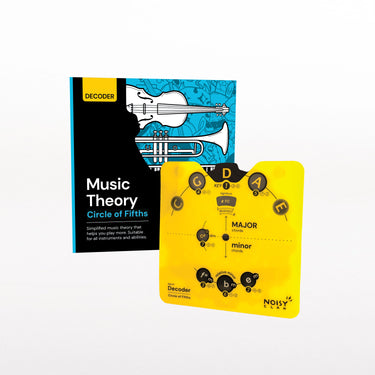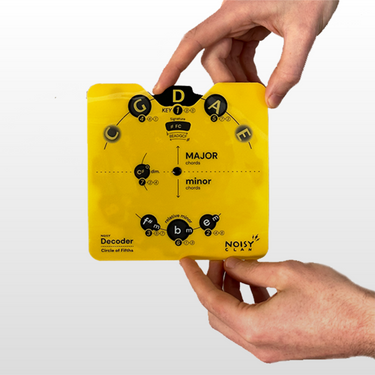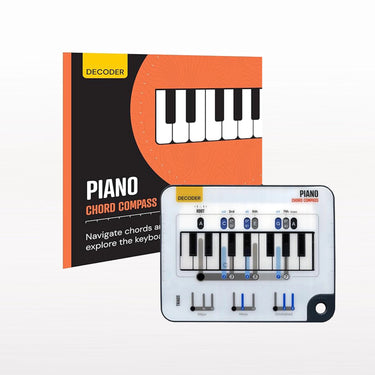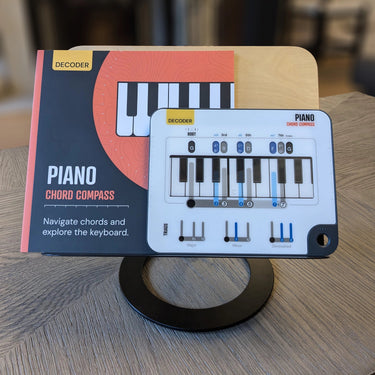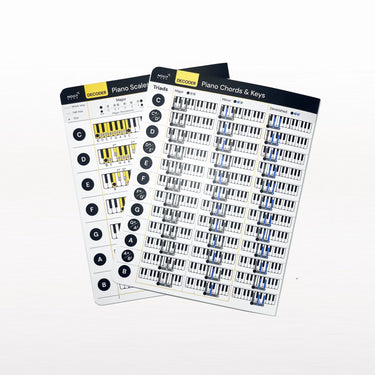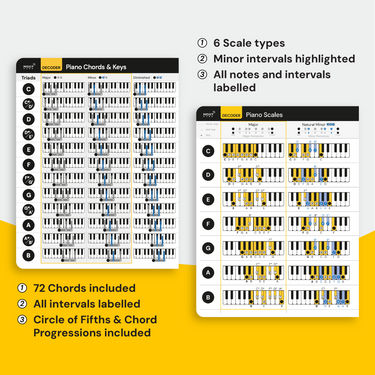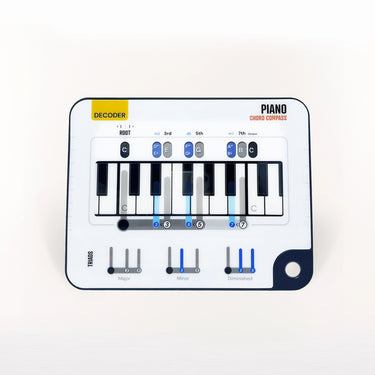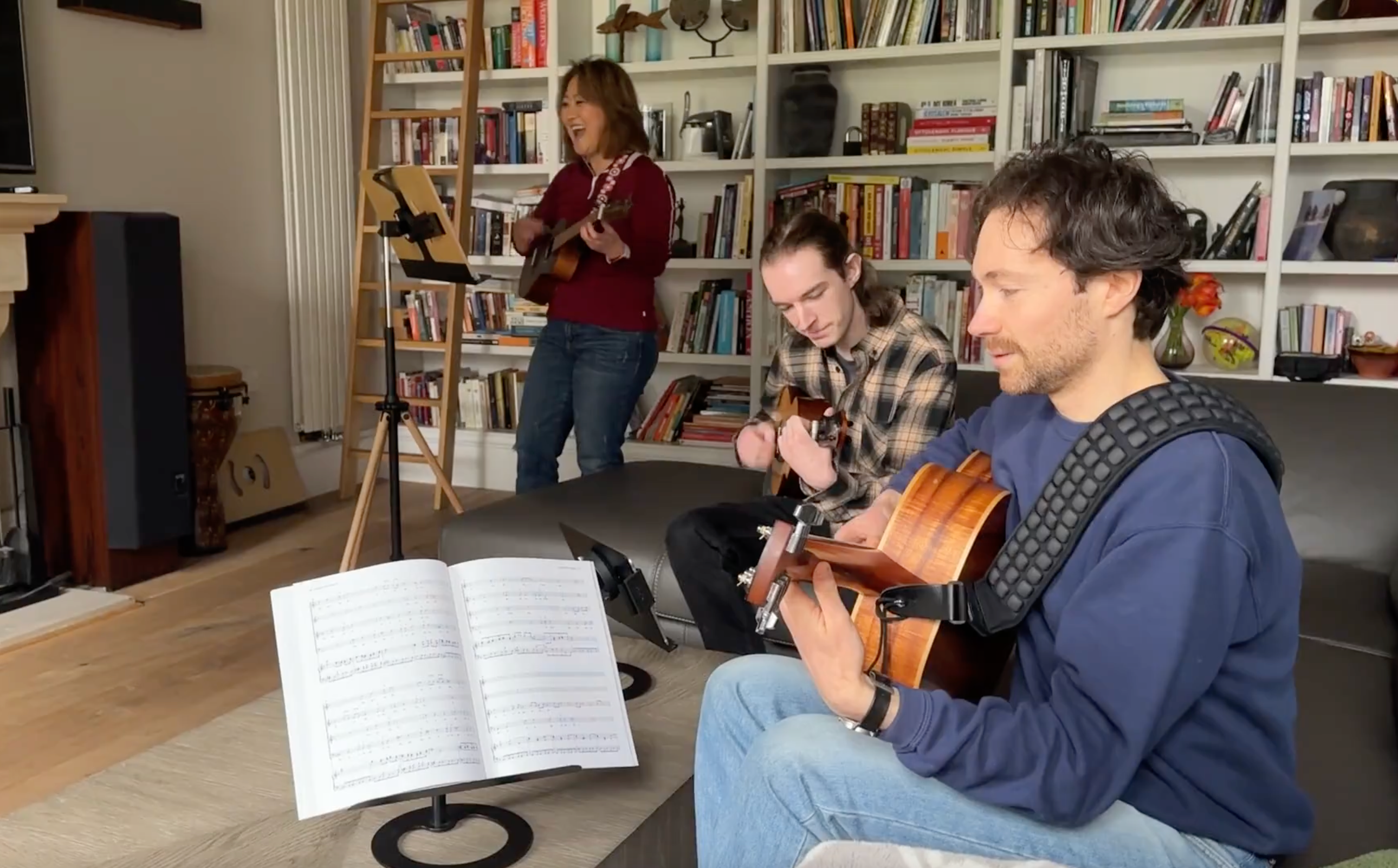
Building chords is like assembling the Lego blocks of music. Without them, you’d just be banging random keys on your piano, hoping to stumble upon something that doesn’t sound like a cat walked across it. Whether you’re a beginner or a seasoned player, learning how to construct chords is essential to understanding piano chords and unleashing your creativity. Plus, if you want to learn piano, chords are the bread and butter of almost every song you’ll ever play.
So, grab your Chord Compass (if you haven’t, we’ll get to why you need one), dust off your piano keys, and let’s dive deep into how to build chords step by step.
What Is a Chord?
Let’s start with the basics: A chord is a combination of notes played together. At its core, the simplest chords are made up of three notes, called triads. These notes are built from the 1st (root), 3rd, and 5th degrees of a scale. Think of them as the foundation of musical harmony.
For example:
-
C Major Chord: C (root) - E (3rd) - G (5th)
-
F Major Chord: F (root) - A (3rd) - C (5th)
Sounds simple, right? Well, it gets even better when you start playing around with chord types, inversions, and progressions.
Major and Minor Chords: The Emotional Building Blocks
Major Chords: The Happy Ones
Major chords sound bright and uplifting. They're the musical equivalent of sunshine and rainbows. Building one is straightforward:
-
Start with the root note (e.g., C).
-
Count up four half steps for the 3rd (e.g., E).
-
Count up three more half steps for the 5th (e.g., G).
Voilà! You’ve got yourself a C Major chord.
Minor Chords: The Melancholy Ones
Minor chords, on the other hand, add a touch of emotion and mystery. The only difference is the 3rd, which is lowered by a half step. Here’s how to build a C Minor chord:
-
Start with the root note (C).
-
Count up three half steps for the minor 3rd (Eb).
-
Count up four half steps for the 5th (G).
The Chord Compass: Your Best Friend
If counting half steps feels tedious, let the Noisy Clan Chord Compass do the heavy lifting. This nifty tool highlights the notes you need for major and minor chords in any key. It’s like having a cheat sheet for every chord on the piano. Want to know the B Major chord? Just find B, D#, and F# on the compass. Boom—instant chord wizardry.
Practice Makes Perfect: Beginner Exercises
Start with these simple exercises to get comfortable with chords:
-
Play the C Major chord using your right hand (C, E, G). Repeat with the left hand.
-
Try transitioning between C Major and G Major. Notice how your fingers adjust.
-
Experiment with different major and minor chords using the Chord Compass.
Advanced Chord Building: Add Some Spice
For those looking to challenge themselves, let’s dig deeper into chord theory.
Seventh Chords
Seventh chords add a whole new layer of complexity and richness. To build a C Major 7th chord:
-
Start with the C Major triad (C, E, G).
-
Add the 7th note of the C major scale (B).
Now you have a jazzy-sounding chord perfect for cocktail parties or impressing your friends.
Suspended Chords
Suspended chords (sus chords) replace the 3rd with either the 2nd or the 4th degree of the scale. For example:
-
C Sus2: C - D - G
-
C Sus4: C - F - G
They’re great for creating tension and anticipation.
Diminished and Augmented Chords
Feeling adventurous? Try building diminished and augmented chords:
-
C Diminished: C - Eb - Gb
-
C Augmented: C - E - G#
These chords are perfect for adding drama and intrigue to your playing.
Song Examples to Bring It All Together
Now that you know the basics, let’s put your knowledge to the test with some real songs:
-
C Major Chord: “Imagine” by John Lennon.
-
G Major Chord: “Let It Be” by The Beatles.
-
Am Chord: “Someone Like You” by Adele.
-
F Major Chord: “Lean On Me” by Bill Withers.
For advanced players, try tackling songs with more complex progressions like:
-
C7 Chord: “Georgia on My Mind” by Ray Charles.
-
C Sus4 Chord: “Free Fallin’” by Tom Petty.
Challenge Yourself: Advanced Exercises
-
Create a chord progression using at least one major, one minor, and one seventh chord. For example: C Major - Am - G7 - F.
-
Experiment with inversions. Play the C Major chord in root position (C, E, G), first inversion (E, G, C), and second inversion (G, C, E).
-
Try modulating between keys. For instance, transition from C Major to G Major seamlessly.
Why You Need the Chord Compass
The Chord Compass is more than just a tool—it’s your gateway to mastering chords effortlessly. Whether you’re a beginner learning your first triads or an advanced player exploring jazz harmonies, this tool simplifies everything.
Ready to take your piano skills to the next level? Download the Noisy Clan Chord Compass and start building beautiful music today. Don’t forget to sign up with your email for free resources, chord charts, and exclusive tips!
Conclusion: Build, Play, Create
Understanding how to build chords is the first step to unlocking your full potential as a pianist. Whether you’re aiming to play pop hits or compose your own music, mastering piano chords is a must. So, fire up your piano, grab your Chord Compass, and let the music flow. Remember, every chord you learn is a new brick in the wall of your musical masterpiece. And if you want to build an even bigger wall, sign up to Noisy Clan! Keep playing, keep learning, and most importantly—have fun! 🎹





